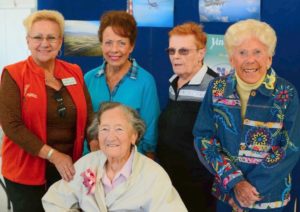 Dreams remain just that if they are not properly propelled to get off the ground. Not one to be stalled on any ambition, pioneer aviatrix Irene Leverton flat-out refused to forsake her passion to fly planes just because the airfields catered to men.
Dreams remain just that if they are not properly propelled to get off the ground. Not one to be stalled on any ambition, pioneer aviatrix Irene Leverton flat-out refused to forsake her passion to fly planes just because the airfields catered to men.
That very dedication mastered by Leverton in the mid-1940s and beyond is reflected in a cadre of determined young women who encounter similar career challenges in the male-dominated aerospace profession even today. However, the courage and resolve of pilot careerists, such as the 89-year-old Leverton and others with her strength and conviction, have no doubt pioneered progress for women in aeronautics.
Leverton began in her journey in aviation during World War II, when the Women Airforce Service Pilots (WASP) were prohibited from flying combat missions or ferrying planes overseas. The WASP program was suspended in 1944, the same year the Chicago-born Leverton completed her first solo in a Piper J-3 Cub.
Then, in 1961, Leverton and 12 other female pilots were shut out of an opportunity to become astronauts because they had no military flying experience. The women had volunteered for and secretly passed the Mercury Space Program’s basic medical tests for becoming NASA astronauts. The privately managed and funded initiative was unexpectedly shuttered. Meanwhile, the Soviets surpassed the United States with both the Sputnik launch and the first woman in space.
The American women pilots “passed the same battery of tests at the legendary Lovelace Foundation as did the Mercury 7 astronauts, but they were summarily dismissed by the boys’ club at NASA and on Capitol Hill.” So states an Amazon synopsis of “The Mercury 13: The True Story of Thirteen Women and the Dream of Space Flight.” Written by journalist/professor Martha Ackmann, the book “tells the story of the dramatic events surrounding these 13 remarkable women, all crackerjack pilots and patriots who sometimes sacrificed jobs and marriages for a chance to participate in America’s space race against the Soviet Union.”
No female astronaut candidates were selected until 1978, when women earned six of 35 seats in a space shuttle class, according to NASA. Subsequently, astronaut Sally Ride became the first American woman in space in 1983 and Eileen Collins was the first woman to pilot the shuttle in 1995. Collins later became the first woman to command a shuttle mission in 1999 and repeated that run in 2005. Now, four of eight members of NASA’s 2013 class are women training for Mars.
“Historically, women in aviation have continued to pave the way and set the path for future women aviators and have encouraged more women to become involved in an industry that is male-predominant,” explained Hannah E. Burright, an upcoming December graduate at Embry-Riddle Aeronautical University (ERAU) in Prescott. “If it were not for women who were brave enough to become pilots, then I would not be able to become a pilot and become successful in the industry. With as few women as there are in aviation today, there are still challenges, but many of [them] have been overcome by pioneer women in aviation.”
Leverton ultimately joined the Civil Air Patrol (CAP) and began learning stalls, spins, forced landings and winter flying on skis from an ex-military flight instructor. She dusted crops in the Midwest and participated as lead pilot in opening ceremonies at Chicago’s Meigs Field in 1950. She graduated with an associate’s degree from San Jose State College in 1976. Her broad piloting expertise included commuter and corporate flights, aircraft ferrying and air ambulance service. She ultimately logged 25,762 flight hours and acquired multiple honors during a 65-year flying career, before retiring her license in 2010.
“Irene loved every minute she was in a plane, no matter what she was doing,” explained her friend, Kathi Schmier. “Her favorite job was working as a check pilot for Japan Airlines. The Japanese respected her ability and she loved the attitude of the Japanese students and their determination and dedication to becoming better pilots. The only reason she left the company was that they wanted her to move to Japan and she did not want to leave the States.”
According to Schmier, Leverton came to Arizona in the early 1980s for a job offer in Phoenix, ultimately settling at Williams airport and then Prescott. She opened her business, Aviation Resource Management, in 1985. While in Prescott, she taught flying and performed check rides for the Federal Aviation Administration. Her skills extended beyond aviation, but flying always remained her passion.
“Irene was a very talented artist and won a scholarship to the Chicago Art Institute, but turned it down, as all she could think about was flying,” Schmier said. “She also was considered an expert in the field of cloud formations and was an accomplished parachute jumper and loved pylon racing at Reno. As an only child and never married, she had no living relatives by the time I became her friend. So I just adopted her and made her a part of my family.”
Leverton was inducted into the Women in Aviation Hall of Fame in 1966 and the Arizona Aviation Hall of Fame in 2004. Also in 2004, she was honored with the Civil Air Patrol’s Commander and Meritorious Service awards. She was presented the Federal Aviation Administration Pilot Award in 2005.
“I didn’t accomplish, I just survived,” quipped the aviatrix when receiving her latest honor, a commemorative plaque presented by North-Aire Aviation in March on behalf of a grateful aviation community. “Bless you,” she responded as well-wishers lined up to reminisce with her.
“She’s a fine lady who has led a long, illustrious life,” noted Dudley Potter, a friend with whom Leverton had worked at Civil Air Patrol (CAP) giving check rides to aspiring pilots. “Historically, she has a lot to tell. She was certainly a pioneer, a female pioneer in the aviation world.”
Tom Richtmyer, who trusts he may be the last student for whom Leverton conducted a check ride through CAP, said she supplied 10 hours of flight time in 2003 and “got me through the check ride. She was a hard taskmaster. You had to be really good to be a pilot under her wing. There were no good old boys on her check rides.”
Today, four to five percent of commercial pilots are women, according to Melanie M. Wilson, Ph.D., director of ERAU’s Women’s and Diversity Center in Prescott. Twenty-three percent of ERAU Prescott’s students are female.
Research indicates that girls who become commercial or military pilots often have an early association with flying between ages five and 10, hands-on flying experience in their teens, and “aviation-obsessed fathers” (many without pilot licenses).
ERAU’s Burright explained that “going to airports and different air shows as a kid always had me intrigued with aviation… When I was a teenager, my dad and I always talked about getting our pilot licenses together, so I had always been interested in becoming a pilot.”
Burright, whose specialty is the fixed-wing professional pilot track, also is earning minors in air traffic management and business administration. She says her main goal for aviation is to become a corporate pilot. “I want to remain an active pilot throughout the rest of my life. I also want to help encourage and promote the growth of aviation, especially [for] women.”
Schmier identified lack of a level playing field as one of Leverton’s annoyances. “I think her biggest challenge was male discrimination or what she perceived to be discrimination. She found out many times that she was doing the same job and making way less money. It was hard for them to get jobs, and also to keep them, as someone always seemed to know a male pilot that they thought could do a better job or was related to upper management.”
Wilson predicts a positive future. “As there are more women flight instructors, more women role models and mentors, we will begin to turn the corner. Sexism still unfortunately plays a significant role in aviation, despite research indicating that women perform as well, if not better, than male pilots. Any assertions to the contrary are based on sexist stereotypes rather than objective reality.”
Multiple campus programs, including Women in Aviation International (WAI), provide role models, mentoring and support to women, Wilson explained. Burright currently serves as president for the local WAI chapter, which maintains about 30 members and an all-female board of directors. Fellow student pilot Claire Schindler is an ambassador in a mentoring program for incoming freshmen, current female students, and recruiters/teachers for middle and high schools.
Cheri Warner, a flight instructor at North-Aire Aviation, ferried Leverton from Cottonwood to the Prescott airport for the March celebration.
“I did not know much about Irene Leverton when I was asked to fly over and get her,” Warner admitted. “I thought it was amazing that she was a female pilot, which wasn’t an easy feat in her era. When I picked her up she was very sweet towards me. She didn’t remember much of her past, but she recognized airports from the air. After getting in the plane, she immediately put her feet on the rudders and held up her finger when a radio call came in and I was talking. Some habits die hard. When we pulled up outside the hangar, she was so excited to see all her friends.”
Warner said, “Seeing women like [Leverton] who paved the trail for me to become a pilot makes me proud to be in this profession and continue the legacy.”
By Sue Marceau, QCBN






Leave a Reply